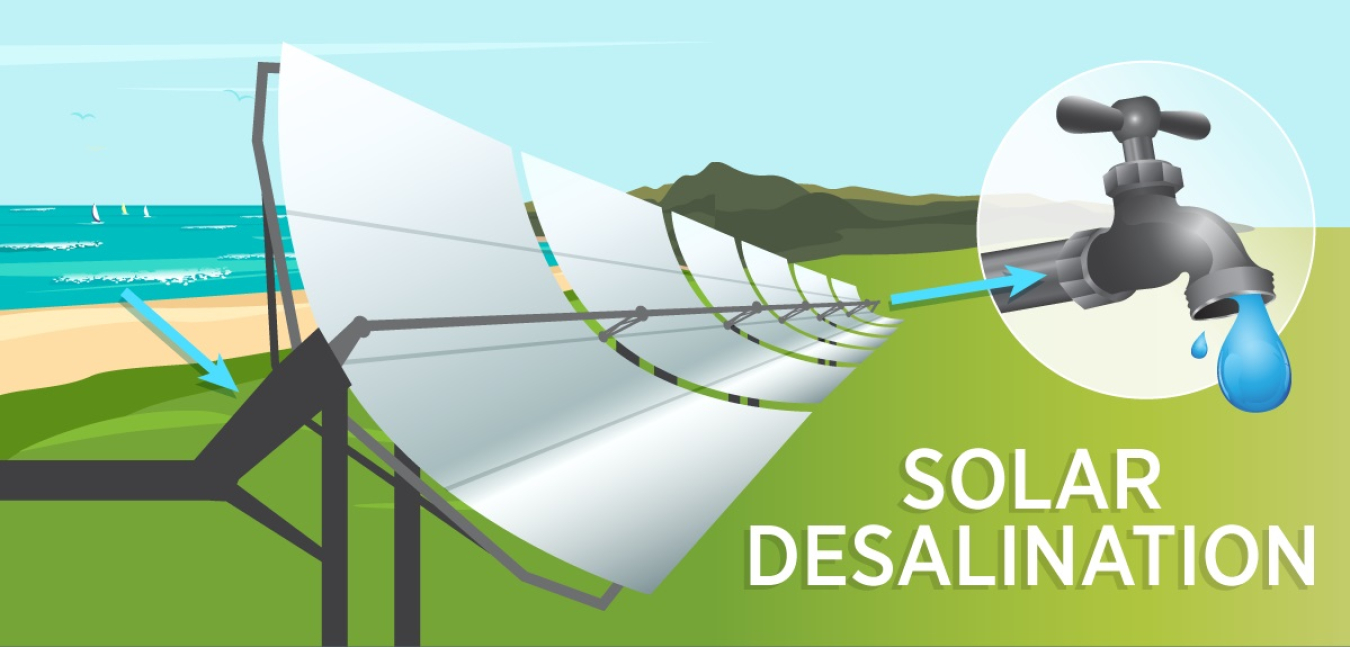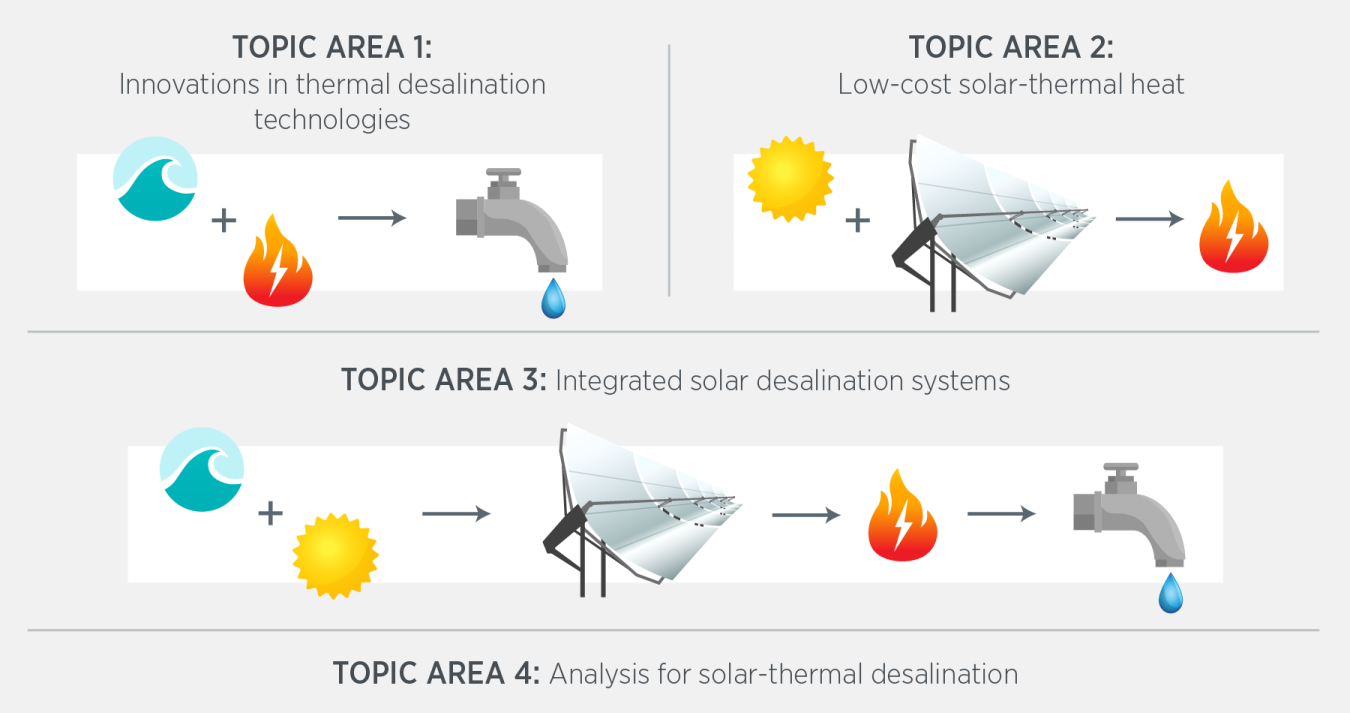
The Solar Desalination funding program will explore novel technologies that use solar-thermal energy to assist in creating freshwater from otherwise unusable waters like seawater, brackish water, and contaminated water. Improvements to thermal desalination technologies and low-cost, integrated designs for solar-thermal collection and storage can reduce the cost of desalination, while also enabling smaller and more portable systems.
The U.S. Department of Energy (DOE) announced selections for Solar Desalination on June 19, 2018. Read the announcement.
On September 23, 2019, DOE announced the American-Made Challenges: Solar Desalination Prize. Learn more.
Approach
The funding program addresses four topic areas:
- In the first area, projects will focus on innovations that improve thermal desalination processes and efficiencies, while addressing challenges like scaling and corrosion.
- In the second topic area, projects will explore low-cost solar-thermal energy collection and storage technology that can reduce the levelized cost of heat (LCOH), as well as incorporate dispatchability and portability features.
- In the third topic area, projects will develop integrated solar-thermal desalination systems that can improve system efficiencies and reduce the levelized cost of water (LCOW).
- In the fourth topic area, the awardee will develop in-depth analysis tools needed to improve solar-thermal desalination.

Objectives
Solar Desalination projects will reduce the LCOW by lowering the LCOH, which will result in more efficient desalination processes and lower overall capital and integration costs for solar-thermal desalination. The projects aim to make improvements to current state-of-the-art and near-commercial systems, produce repeatable results, and include clear, market-driven objectives. Successful sub-components will be tested in an integrated system and will determine a credible pathway to commercial development.
Projects that address challenges for large-scale plants processing high-volume, low-salinity water, like sea water for a municipal utility, are expected to target a LCOW of $0.50 per cubic meter, to achieve wide applicability in the United States. Projects that address challenges for small-scale plants processing low-volume, high-salinity water, like brine from oil and gas operations target a LCOW of $1.50 per cubic meter.
Selectees
-- Award and cost share amounts are subject to change pending negotiations –
Topic Area 1: Innovations in thermal desalination technologies
Project Name: Solar-Driven Desalination by Membrane Distillation using Ceramic Membranes
Location: Storrs, CT
DOE Award Amount: $800,000
Awardee Cost Share: $332,088
Principal Investigator: Jeffrey McCutcheon
Project Summary: This project will develop and test ceramic membranes for solar-driven membrane distillation (MD) systems for desalination. The challenges that ceramic membranes face for MD applications are mass and heat transfer, wetting, scaling, and fouling. These challenges will be addressed by designing and optimizing membranes at a small scale, and later applying the lessons learned to larger-scale elements that can be used with a solar-thermal test bed.
Project Name: High-Efficiency, Zero Liquid Discharge, Multiple-Effect Adsorption Distillation
Location: Hamilton, NJ
DOE Award Amount: $1,600,000
Awardee Cost Share: $400,000
Principal Investigator: Dr. Howard Yuh
Project Summary: Adsorption distillation, a technology based on using materials that are able to adsorb large volumes of water vapor, is well-suited for zero liquid discharge applications where the incoming brine or waste water must be completely separated to produce only purified water and solid salt. This team will develop a multi-stage adsorption water distiller with the ability to use the same adsorbent beds for both a liquid-only distiller to concentrate brine and a liquid-solid crystallizer to generate solid salt by-products, by only altering only the input mechanics.
Project Name: Direct Solar-Thermal Forward Osmosis Desalination of Produced Waters
Location: Berkeley, CA
DOE Award Amount: $800,000
Awardee Cost Share: $200,000
Principal Investigator: Robert Kostecki
Project Summary: This team will develop an integrated ionic liquid-based forward-osmosis water treatment system for waters produced from high-salinity and/or high total dissolved solids levels which cannot be treated directly by reverse osmosis. By enabling the use of low-grade solar heat to drive the separation and regeneration processes at a small capacity, this technology will allow for integrated desalination systems that can be built at a low capital cost.
Project Name: Zero Liquid Discharge Water Desalination Process using Humidification-Dehumidification in a Thermally Actuated Transport Reactor
Location: Bend, OR
DOE Award Amount: $2,000,000
Awardee Cost Share: $500,000
Principal Investigator: Bahman Abbasi
Project Summary: This project will develop a hybrid process to treat high-salinity water with zero liquid discharge. The cost and efficiency of energy consumption are targeted to be competitive with large reverse osmosis desalination plants at a fraction of the capital cost. This will be accomplished by using thermally actuated nozzles—components that operate in response to temperature changes—that are heated with low-grade solar heat. These hot air jets are humidified with brine and the solid particles can be separated out. By condensing the water vapor and recouping the heat, this process will target a highly energy efficient cycle.
Project Name: Energy Where it Matters: Delivering Heat to the Membrane/Water Interface for Enhanced Thermal Desalination
Location: Los Angeles, CA
DOE Award Amount: $1,995,249
Awardee Cost Share: $516,644
Principal Investigator: David Jassby
Project Summary: This project will modify a typical membrane distillation (MD) system by deploying layers of materials with high thermal and electrical conductivity at the membrane/water interface. These conductive materials will be able to deliver solar-thermal energy directly to where it’s needed in the MD system. By directly coupling the membrane surface to a thermal input, this technology has the potential to be substantially more energy efficient than current MD systems.
Project Name: Ultra-Compact and Efficient Heat Exchanger for Solar Desalination with Unprecedented Scaling Resistance
Location: Urbana, IL
DOE Award Amount: $1,584,349
Awardee Cost Share: $397,306
Principal Investigator: Anthony Jacobi
Project Summary: This project will design, develop, and test novel coatings for heat exchanger surfaces in high-temperature thermal desalination applications which aim to increase heat exchanger efficiency by 150 percent or more than current state-of-the-art technology. This will help address challenges like fouling and scaling as well as corrosion resistance that occurs at temperatures above 200 °Celsius.
Project Name: Supercritical Treatment Technology for Water Purification
Location: Grand Forks, ND
DOE Award Amount: $1,999,999
Awardee Cost Share: $511,145
Principal Investigator: Dr. Michael D. Mann
Project Summary: This project will develop a technology called Supercritical Water Extraction – Enhanced Targeted Recovery (SWEETR™). This technology uses the insolubility of dissolved salts as water is heated and pressurized to a supercritical state. This project will make improvements in the technology to eliminate corrosion and scaling, reduce energy requirements, simplify the deployment and portability of the technology, and reduce the cost of treatment to less than $1.50 per cubic meter.
Topic Area 2: Low-cost solar-thermal energy collection and storage
Project Name: Loop Thermosyphon Enhanced Solar Collector
Location: Lancaster, PA
DOE Award Amount: $1,500,000
Awardee Cost Share: $500,000
Principal Investigator: Fangyu Cao
Project Summary: This team will develop a loop thermosyphon solar collection system for efficient, low-cost solar-thermal desalination that does not require fluid to be actively pumped throughout the system. The design will take advantage of nanofluids with higher solar absorptivity and a two-phase thermosyphon to improve the system’s efficiency and simplify the collection of solar-thermal energy used in desalination processes.
Project Name: SkyTrough Vacuum Membrane: An Extreme Low-Cost Solar-Thermal Collector for Desalination
Location: Lakewood, CO
DOE Award Amount: $1,598,814
Awardee Cost Share: $399,704
Principal Investigator: Nathan Schuknecht
Project Summary: To reduce the levelized cost of heat from solar-thermal energy, this project aims to achieve a substantial reduction in capital and integration costs by developing a novel, membrane-based, lightweight parabolic trough solar collector. In conjunction with the design of the collector, an associated heat transfer fluid delivery system and a low-temperature thermal energy storage system will be designed and integrated into a complete solar-thermal system.
Project Name: Solar Steam on Demand
Location: Livermore, CA
DOE Award Amount: $1,500,000
Awardee Cost Share: $1,000,000
Principal Investigator: Philip Gleckman
Project Summary: The most efficient distillation processes that use heat recovery require a steam source at a temperature around 180 °Celsius. This project will develop a novel solution for generating steam by using solar-thermal energy as the primary source of heat and developing a thermal energy storage solution for this temperature range based on phase-change materials. This solution will be combined with a previously developed low-cost, high-performance solar collector, creating a system that has the potential to continuously operate its distillation equipment and deliver a levelized cost of heat of 1.5 cent per kilowatt-hour even when the sun is not shining. Called Solar Steam on Demand, this solution meets the same requirements that exist in many other industrial heating applications.
Project Name: Low-Cost Dispatchable Heat for Small-Scale Solar-Thermal Desalination Systems
Location: Merced, CA
DOE Award Amount: $1,081,793
Awardee Cost Share: $277,133
Principal Investigator: Roland Winston
Project Summary: This team will design, build a prototype, and test a novel, low-cost solar-thermal energy system that can reduce the levelized cost of heat to below 1.5 cent per kilowatt-hour thermal, while also incorporating dispatchability and portability features. The project includes the design and development of a new collector or concentrator, called the Integrated Compound Parabolic Concentrator, as well as the design and development of an accompanying thermal energy storage system.
Topic Area 3: Integrated solar-thermal desalination systems
Project Name: Hawaii SunShot Desal Project
Location: Kailua-Kona, HI
DOE Award Amount: $1,928,238
Awardee Cost Share: $2,311,938
Principal Investigator: Gregory P. Barbour
Project Summary: This project will advance the techno-economic viability of solar-powered forward osmosis (FO) by reducing the levelized cost of water (LCOW) 40 percent less than that of current state-of-the-art technology. The team will demonstrate a system that incorporates a concentrating solar thermal collector array delivering heat to a FO system. This system will utilize a new generation of membranes whose energy efficiency and durability will be demonstrated in this project. This system will then be installed and operated at an oceanic facility and the results will be used to scale up to a commercial-sized facility that can achieve the low targeted LCOW.
Project Name: Low-Cost Desalination using Nanophotonics-Enhanced Direct Solar Membrane Distillation
Location: Houston, TX
DOE Award Amount: $1,700,000
Awardee Cost Share: $787,124
Principal Investigator: Qilin Li
Project Summary: This project will develop and test a novel solar-thermal desalination process called Nanophotonics-Enabled Solar Membrane Distillation (NESMD), which uses a porous, photothermal membrane to simultaneously convert sunlight to heat and desalinate water by membrane distillation with very high thermal efficiency. The NESMD technology will go through a system-level integration and evaluation at the pilot-scale.
Topic Area 4: Analysis for solar-thermal desalination
Project Name: GIS-Based Graphical User Interface Tools for Analyzing Solar-Thermal Desalination Systems and High-Potential Implementation Regions
Location: New York, NY
DOE Award Amount: $972,797
Awardee Cost Share: $274,481
Principal Investigator: Vasilis Fthenakis
Project Summary: This project will develop a software with state-of-the-art solar-thermal desalination models, verified with data from operating thermal desalination plants and data from solar-thermal desalination pilots at Plataforma Solar de Almeria in Tabernas, Spain. The software will also incorporate newly developed geospatial databases of alternative water resources. By integrating desalination techno-economic models and geospatial data layers in one interface, the developed software will assist with the planning and valuation of solar-thermal and hybrid technologies.
Learn more about the Solar Energy Technologies Office’s concentrating solar thermal power research.

